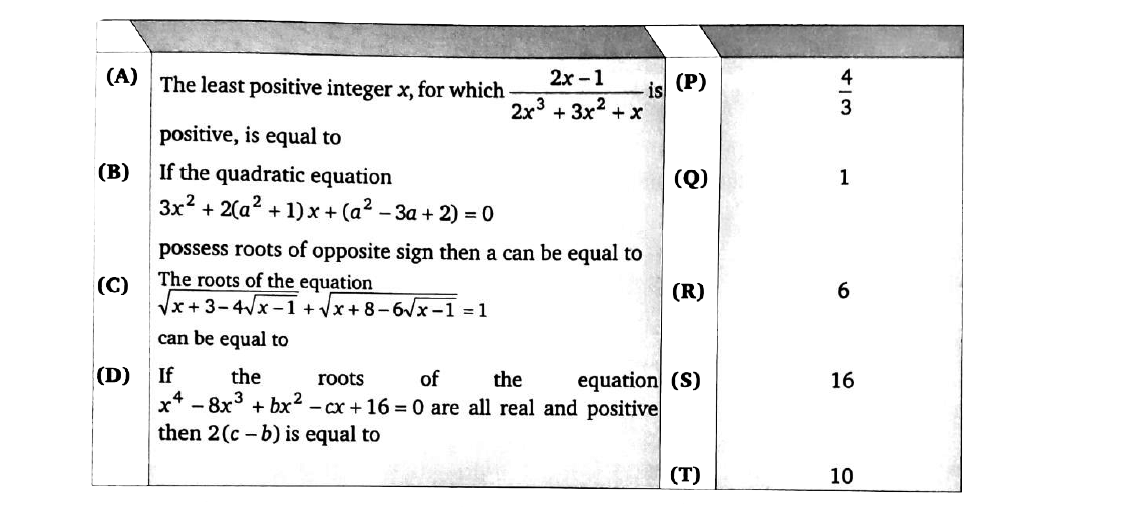Let f(x)=x2−4x+c∀x∈R, where c is a real constant, then which of the following is/are true ?
f(0)>f(1)>f(2)
f(2)>f(3)>f(4)
f(1)<f(4)<f(−1)
f(0)=f(4)>f(3)
The correct Answer is:A, C, D
To solve the problem, we need to analyze the function f(x)=x2−4x+c and determine the truth of the given options based on its properties.
1. Identify the function and its derivative:
f(x)=x2−4x+c
The derivative of the function is:
f′(x)=2x−4
Hint: The derivative helps us find critical points where the function may have maxima or minima.
2. Find critical points by setting the derivative to zero:
2x−4=0⟹x=2
Hint: Critical points are found where the derivative equals zero.
3. Determine the nature of the critical point:
To determine whether x=2 is a maximum or minimum, we can use the second derivative test or analyze the sign of the first derivative around x=2.
- If we choose a value less than 2 (e.g., x=1):
f′(1)=2(1)−4=−2(negative, function is decreasing)
- If we choose a value greater than 2 (e.g., x=3):
f′(3)=2(3)−4=2(positive, function is increasing)
Since f′(x) changes from negative to positive at x=2, this indicates that x=2 is a point of minimum.
Hint: The sign of the derivative tells us whether the function is increasing or decreasing.
4. Evaluate the function at specific points to analyze options:
- For x=0:
f(0)=02−4(0)+c=c
- For x=1:
f(1)=12−4(1)+c=c−3
- For x=3:
f(3)=32−4(3)+c=9−12+c=c−3
- For x=4:
f(4)=42−4(4)+c=16−16+c=c
- For x=−1:
f(−1)=(−1)2−4(−1)+c=1+4+c=5+c
Hint: Evaluating the function at specific points helps us understand its behavior.
5. Analyze the results:
- From the evaluations:
- f(0)=c
- f(1)=c−3
- f(3)=c−3
- f(4)=c
- f(−1)=5+c
We can see that:
- f(0)=f(4)
- f(1)=f(3)<f(0)=f(4)
- f(−1)>f(0)=f(4)
This indicates that the function is decreasing from x=0 to x=1, reaching a minimum at x=2, and then increasing thereafter.
6. Conclusion:
Based on the analysis, we can conclude:
- Option A is true (function decreases until x=2).
- Option B is false (function does not decrease for x≥2).
- Option C is true (function increases and then decreases).
- Option D is true (function has the same value at x=0 and x=4, with a minimum at x=2).
Therefore, the final answer is:
- Correct options: A, C, D.
f(x)=x2−4x+c
The derivative of the function is:
f′(x)=2x−4
2x−4=0⟹x=2
To determine whether x=2 is a maximum or minimum, we can use the second derivative test or analyze the sign of the first derivative around x=2.
f′(1)=2(1)−4=−2(negative, function is decreasing)
- If we choose a value greater than 2 (e.g., x=3):
f′(3)=2(3)−4=2(positive, function is increasing)
- For x=0:
f(0)=02−4(0)+c=c
- For x=1:
f(1)=12−4(1)+c=c−3
- For x=3:
f(3)=32−4(3)+c=9−12+c=c−3
- For x=4:
f(4)=42−4(4)+c=16−16+c=c
- For x=−1:
f(−1)=(−1)2−4(−1)+c=1+4+c=5+c
- From the evaluations:
- f(0)=c
- f(1)=c−3
- f(3)=c−3
- f(4)=c
- f(−1)=5+c
- f(0)=f(4)
- f(1)=f(3)<f(0)=f(4)
- f(−1)>f(0)=f(4)
Based on the analysis, we can conclude:
- Option A is true (function decreases until x=2).
- Option B is false (function does not decrease for x≥2).
- Option C is true (function increases and then decreases).
- Option D is true (function has the same value at x=0 and x=4, with a minimum at x=2).
- Correct options: A, C, D.
Topper's Solved these Questions
- QUADRATIC EQUATIONS BOOK - VIKAS GUPTA (BLACK BOOK) ENGLISHCHAPTER - QUADRATIC EQUATIONS EXERCISE - EXERCISE (COMPREHENSION TYPE PROBLEMS)
23 Videos
- QUADRATIC EQUATIONS BOOK - VIKAS GUPTA (BLACK BOOK) ENGLISHCHAPTER - QUADRATIC EQUATIONS EXERCISE - EXERCISE (MATCHING TYPE PROBLEMS)
4 Videos
- QUADRATIC EQUATIONS BOOK - VIKAS GUPTA (BLACK BOOK) ENGLISHCHAPTER - QUADRATIC EQUATIONS EXERCISE - EXERCISE (SUBJECTIVE TYPE PROBLEMS)
45 Videos
- PROBABILITY BOOK - VIKAS GUPTA (BLACK BOOK) ENGLISHCHAPTER - PROBABILITY EXERCISE - Exercise -5 : Subjective Type problems
11 Videos
- SEQUENCE AND SERIES BOOK - VIKAS GUPTA (BLACK BOOK) ENGLISHCHAPTER - SEQUENCE AND SERIES EXERCISE - EXERCISE (SUBJECTIVE TYPE PROBLEMS)
21 Videos
Similar Questions
Let f(x)=ax2+bx+c,a≠0, such the f(−1−x)=f(−1+x)∀x∈R. Also given that f(x)=0 has no real roots and 4a+b>0.
Let α=4a−2b+c,β=9a+3b+c,γ=9a−3b+c, then which of the following is correct ?
View Solution
View SolutionLet f(x)=ax2+bx+c where a,b,c are integers. If sinπ7.sin3π7+sin5x7+sin5π7sin5π7+sinπ7=f(cosπ7), then find the value of f(2):
View SolutionMr. A writes an article. The article originally is error free. Each day Mr. B introduces one new error into the article. At the end of the day, Mr. A checks the article and has 23 chance of catching each individual error still in the article. After 3 days, the probability that the article is error free can be expressed as pq where p and q are relatively prime positive integers. Let λ=q−p, then find the sum of the digits of λ.
View SolutionLet a,b,c,d be four distinct real number in A.P.Then the smallest positive vlaue of k satisfying 2(a−b)+k(b−c)2+(c−a)3=2(a−d)+(b−d)2+(c−d)3is_________
View SolutionLet f(x)=x^(2)-4x+c wyhere c is a real constant,then which of the following is NOT true
View SolutionLet f:R rarr R be a real valued function such that f(10+x)=f(10-x)AA x in R and f(20+x)=-f(20-x)AA x in R then which of the following statements are true
View SolutionLet f(x)=x^(2)+px-2,g(x)=px^(2)+x+(p+2)AA x in R where p is a real constant.If f(x)>g(x)AA x in R, then the range of p is (-oo,-(m)/(n)) where m and n are coprime.Find the value of (m-5n)
View SolutionLet f(x)=a+b|x|+c|x|2, where a,b,c are real constants. The, f'(0) exists if
View SolutionLet f(x)=asinx+c, where a and c are real numbers and a>0. Then f(x)<0,∀x∈R if
View SolutionLet f(x)=ax2+bx+c,a>=andf(2−x)=f(2+x)∀x∈Randf(x)=0 has 2 distinct real roots, then which of the following is true ?
View SolutionLet f(x)=x2−4x+c∀x∈R, where c is a real constant, then which of the following is/are true ?
View SolutionLet a function f:R→R, where R is the set of real nos. satisfying the equation f(x+y)=f(x)+f(y)∀x,y if f(x) is continuous at x = 0, then
View SolutionLet f:R→R be a function defined by f(x)=4x−3∀x∈R. Then Write f−1.
View SolutionLet X ={(abcd):a,b,c,d∈R} Define f:X→R by f(A) = det (A) , ∀A∈x. then , f is
View Solution
